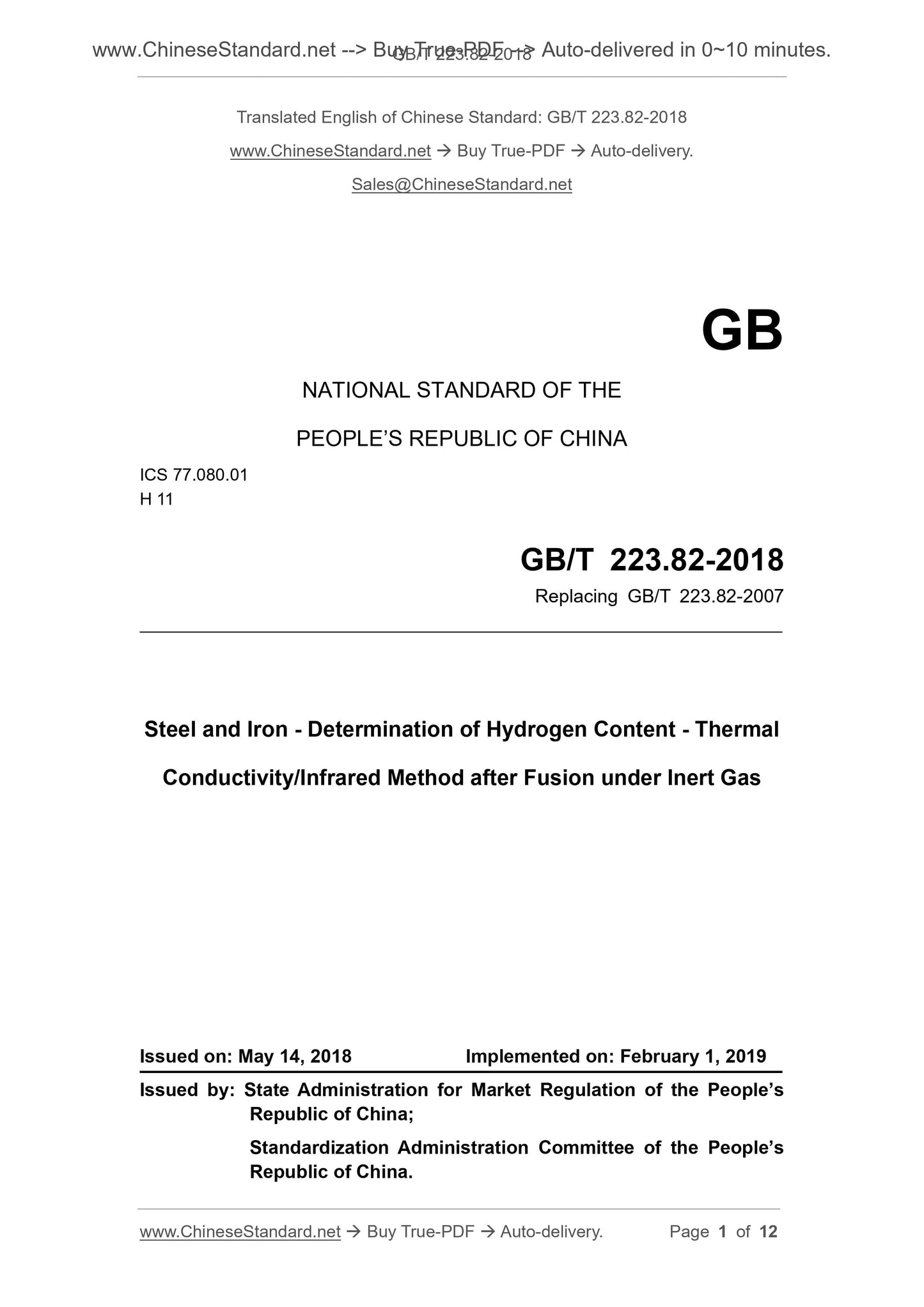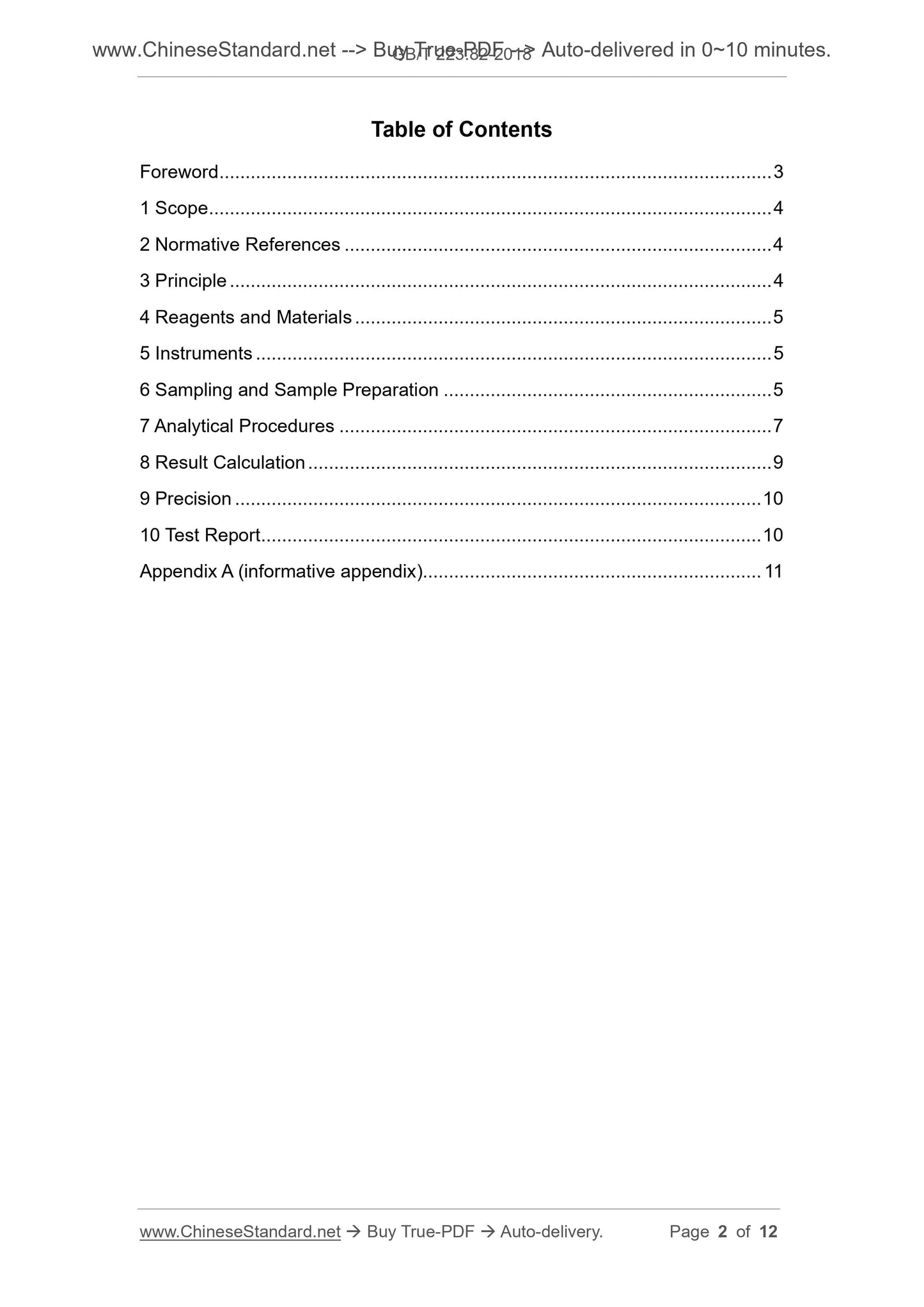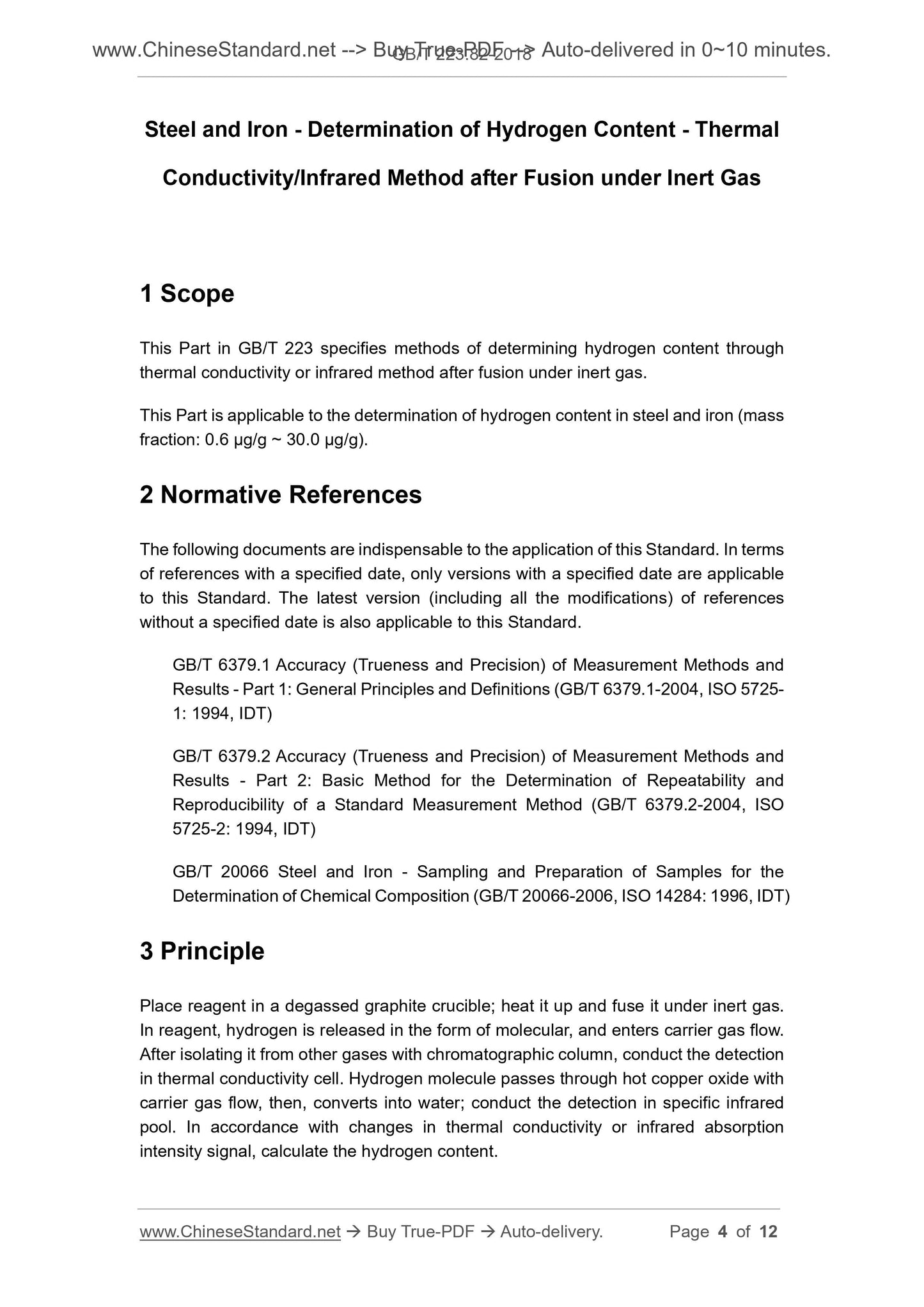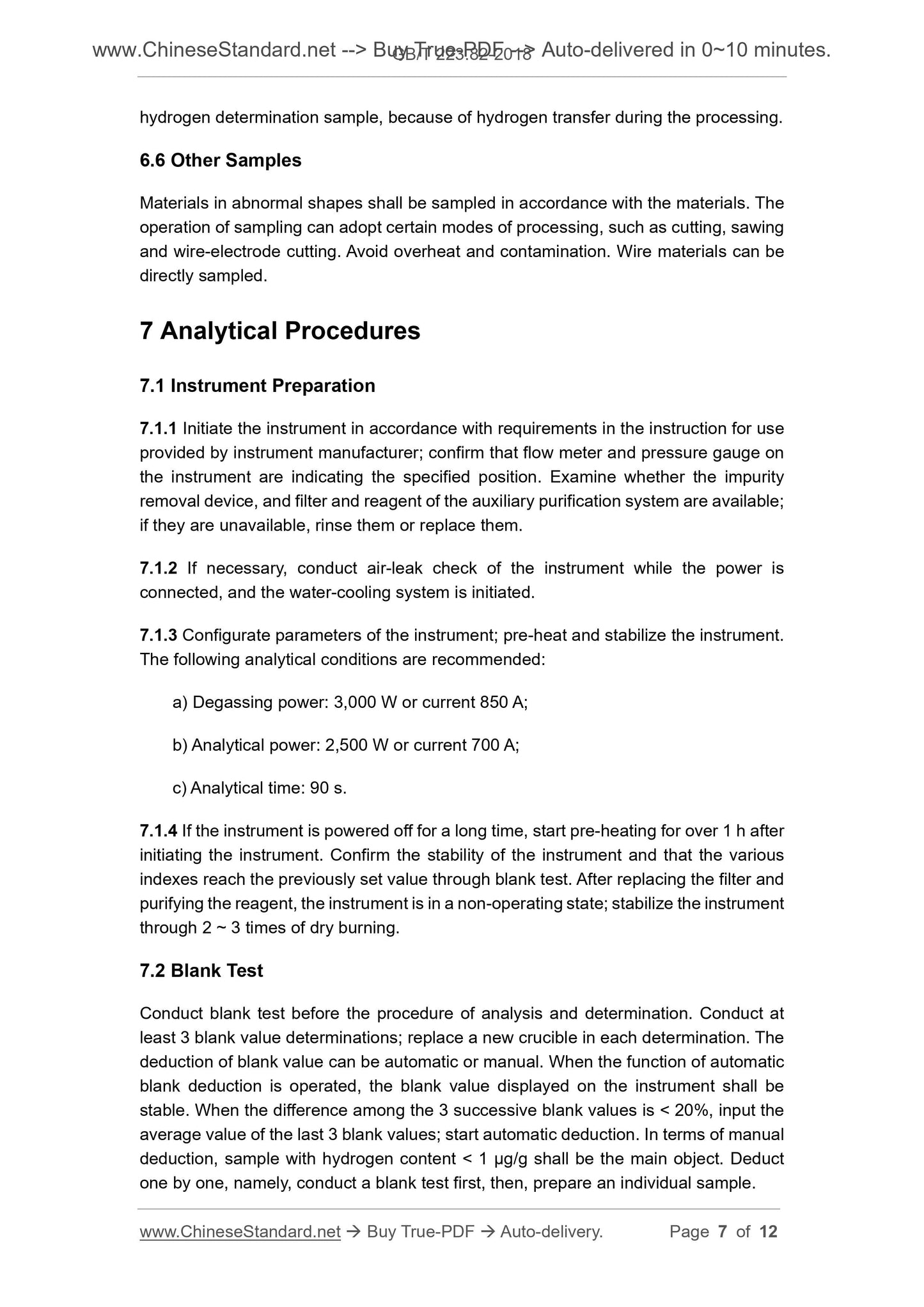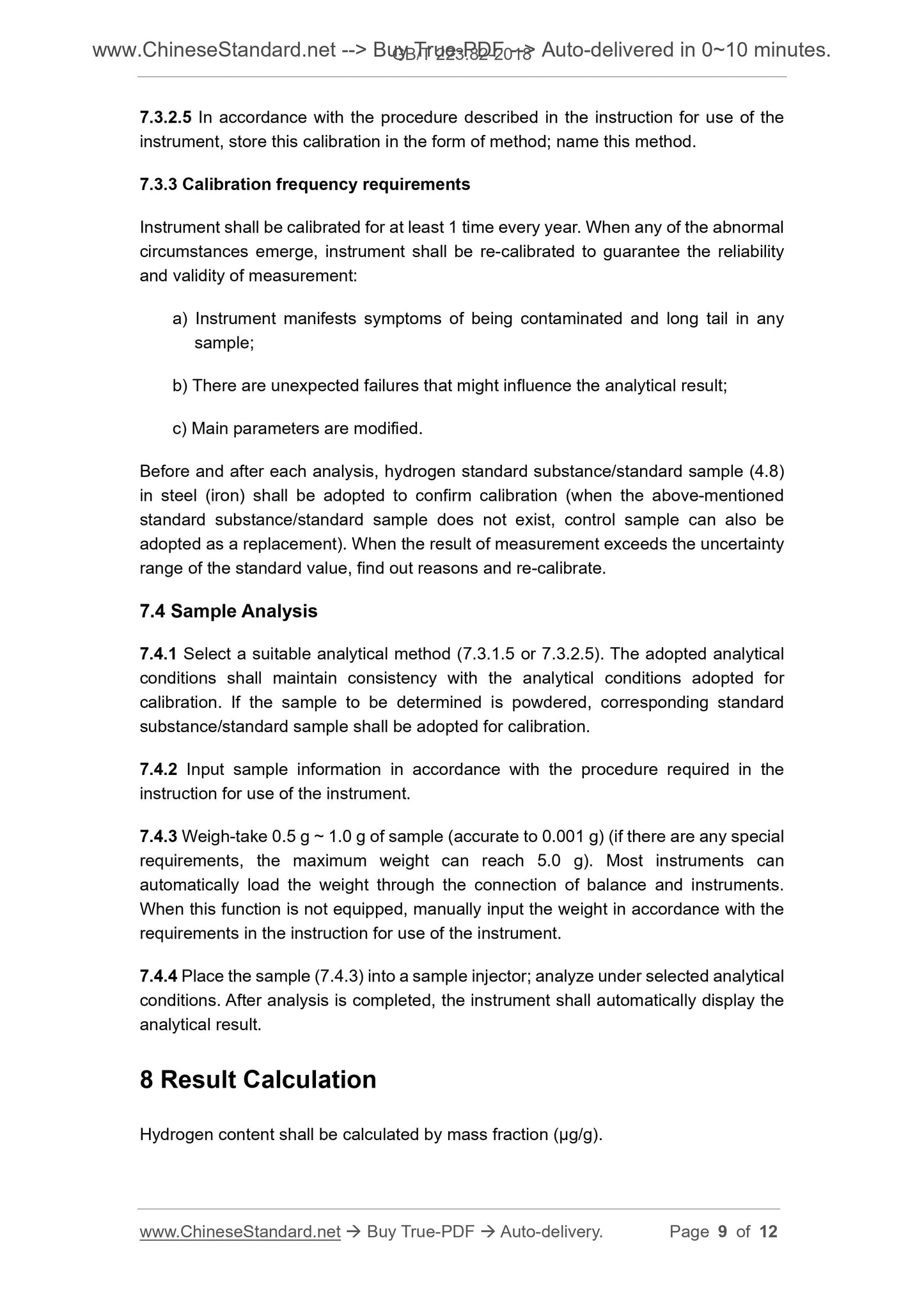1
/
of
5
PayPal, credit cards. Download editable-PDF and invoice in 1 second!
GB/T 223.82-2018 English PDF (GBT223.82-2018)
GB/T 223.82-2018 English PDF (GBT223.82-2018)
Regular price
$135.00 USD
Regular price
Sale price
$135.00 USD
Unit price
/
per
Shipping calculated at checkout.
Couldn't load pickup availability
Delivery: 3 seconds. Download true-PDF + Invoice.
Get QUOTATION in 1-minute: Click GB/T 223.82-2018
Historical versions: GB/T 223.82-2018
Preview True-PDF (Reload/Scroll if blank)
GB/T 223.82-2018: Steel and iron -- Determination of hydrogen content -- Thermal conductivity/infrared method after fusion under inert gas
GB/T 223.82-2018
GB
NATIONAL STANDARD OF THE
PEOPLE’S REPUBLIC OF CHINA
ICS 77.080.01
H 11
Replacing GB/T 223.82-2007
Steel and Iron - Determination of Hydrogen Content - Thermal
Conductivity/Infrared Method after Fusion under Inert Gas
ISSUED ON. MAY 14, 2018
IMPLEMENTED ON. FEBRUARY 1, 2019
Issued by. State Administration for Market Regulation of the People’s
Republic of China;
Standardization Administration Committee of the People’s
Republic of China.
Table of Contents
Foreword ... 3
1 Scope ... 4
2 Normative References ... 4
3 Principle ... 4
4 Reagents and Materials ... 5
5 Instruments ... 5
6 Sampling and Sample Preparation ... 5
7 Analytical Procedures ... 7
8 Result Calculation ... 9
9 Precision ... 10
10 Test Report ... 10
Appendix A (informative appendix)... 11
Steel and Iron - Determination of Hydrogen Content - Thermal
Conductivity/Infrared Method after Fusion under Inert Gas
1 Scope
This Part in GB/T 223 specifies methods of determining hydrogen content through
thermal conductivity or infrared method after fusion under inert gas.
This Part is applicable to the determination of hydrogen content in steel and iron (mass
fraction. 0.6 μg/g ~ 30.0 μg/g).
2 Normative References
The following documents are indispensable to the application of this Standard. In terms
of references with a specified date, only versions with a specified date are applicable
to this Standard. The latest version (including all the modifications) of references
without a specified date is also applicable to this Standard.
GB/T 6379.1 Accuracy (Trueness and Precision) of Measurement Methods and
Results - Part 1. General Principles and Definitions (GB/T 6379.1-2004, ISO 5725-
1.1994, IDT)
GB/T 6379.2 Accuracy (Trueness and Precision) of Measurement Methods and
Results - Part 2. Basic Method for the Determination of Repeatability and
Reproducibility of a Standard Measurement Method (GB/T 6379.2-2004, ISO
5725-2.1994, IDT)
GB/T 20066 Steel and Iron - Sampling and Preparation of Samples for the
Determination of Chemical Composition (GB/T 20066-2006, ISO 14284.1996, IDT)
3 Principle
Place reagent in a degassed graphite crucible; heat it up and fuse it under inert gas.
In reagent, hydrogen is released in the form of molecular, and enters carrier gas flow.
After isolating it from other gases with chromatographic column, conduct the detection
in thermal conductivity cell. Hydrogen molecule passes through hot copper oxide with
carrier gas flow, then, converts into water; conduct the detection in specific infrared
pool. In accordance with changes in thermal conductivity or infrared absorption
intensity signal, calculate the hydrogen content.
hydrogen determination sample, because of hydrogen transfer during the processing.
6.6 Other Samples
Materials in abnormal shapes shall be sampled in accordance with the materials. The
operation of sampling can adopt certain modes of processing, such as cutting, sawing
and wire-electrode cutting. Avoid overheat and contamination. Wire materials can be
directly sampled.
7 Analytical Procedures
7.1 Instrument Preparation
7.1.1 Initiate the instrument in accordance with requirements in the instruction for use
provided by instrument manufacturer; confirm that flow meter and pressure gauge on
the instrument are indicating the specified position. Examine whether the impurity
removal device, and filter and reagent of the auxiliary purification system are available;
if they are unavailable, rinse them or replace them.
7.1.2 If necessary, conduct air-leak check of the instrument while the power is
connected, and the water-cooling system is initiated.
7.1.3 Configurate parameters of the instrument; pre-heat and stabilize the instrument.
The following analytical conditions are recommended.
a) Degassing power. 3,000 W or current 850 A;
b) Analytical power. 2,500 W or current 700 A;
c) Analytical time. 90 s.
7.1.4 If the instrument is powered off for a long time, start pre-heating for over 1 h after
initiating the instrument. Confirm the stability of the instrument and that the various
indexes reach the previously set value through blank test. After replacing the filter and
purifying the reagent, the instrument is in a non-operating state; stabilize the instrument
through 2 ~ 3 times of dry burning.
7.2 Blank Test
Conduct blank test before the procedure of analysis and determination. Conduct at
least 3 blank value determinations; replace a new crucible in each determination. The
deduction of blank value can be automatic or manual. When the function of automatic
blank deduction is operated, the blank value displayed on the instrument shall be
stable. When the difference among the 3 successive blank values is < 20%, input the
average value of the last 3 blank values; start automatic deduction. In terms of manual
deduction, sample with hydrogen content < 1 μg/g shall be the main object. Deduct
one by one, namely, conduct a blank test first, then, prepare an individual sample.
7.3.2.5 In accordance with the procedure described in the instruction for use of the
instrument, store this calibration in the form of method; name this method.
7.3.3 Calibration frequency requirements
Instrument shall be calibrated for at least 1 time every year. When any of the abnormal
circumstances emerge, instrument shall be re-calibrated to guarantee the reliability
and validity of measurement.
a) Instrument manifests symptoms of being contaminated and long tail in any
sample;
b) There are unexpected failures that might influence the analytical result;
c) Main parameters are modified.
Before and after each analysis, hydrogen standard substance/standard sample (4.8)
in steel (iron) shall be adopted to confirm calibration (when the above-mentioned
standard substance/standard sample does not exist, control sample can also be
adopted as a replacement). When the result of measurement exceeds the uncertainty
range of the standard value, find out reasons and re-calibrate.
7.4 Sample Analysis
7.4.1 Select a suitable analytical method (7.3.1.5 or 7.3.2.5). The adopted analytical
conditions shall maintain consistency with the analytical conditions adopted for
calibration. If the sample to be determined is powdered, corresponding standard
substance/standard sample shall be adopted for calibration.
7.4.2 Input sample information in accordance with the procedure required in the
instruction for use of the instrument.
7.4.3 Weigh-take 0.5 g ~ 1.0 g of sample (accurate to 0.001 g) (if there are any special
requirements, the maximum weight can reach 5.0 g). Most instruments can
automatically load the weight through the connection of balance and instruments.
When this function is not equipped, manually input the weight in accordance with the
requirements in the instruction for use of the instrument.
7.4.4 Place the sample (7.4.3) into a sample injector; analyze under selected analytical
conditions. After analysis is completed, the instrument shall automatically display the
analytical result.
8 Result Calculation
Hydrogen content shall be calculated by mass fraction (μg/g).
Get QUOTATION in 1-minute: Click GB/T 223.82-2018
Historical versions: GB/T 223.82-2018
Preview True-PDF (Reload/Scroll if blank)
GB/T 223.82-2018: Steel and iron -- Determination of hydrogen content -- Thermal conductivity/infrared method after fusion under inert gas
GB/T 223.82-2018
GB
NATIONAL STANDARD OF THE
PEOPLE’S REPUBLIC OF CHINA
ICS 77.080.01
H 11
Replacing GB/T 223.82-2007
Steel and Iron - Determination of Hydrogen Content - Thermal
Conductivity/Infrared Method after Fusion under Inert Gas
ISSUED ON. MAY 14, 2018
IMPLEMENTED ON. FEBRUARY 1, 2019
Issued by. State Administration for Market Regulation of the People’s
Republic of China;
Standardization Administration Committee of the People’s
Republic of China.
Table of Contents
Foreword ... 3
1 Scope ... 4
2 Normative References ... 4
3 Principle ... 4
4 Reagents and Materials ... 5
5 Instruments ... 5
6 Sampling and Sample Preparation ... 5
7 Analytical Procedures ... 7
8 Result Calculation ... 9
9 Precision ... 10
10 Test Report ... 10
Appendix A (informative appendix)... 11
Steel and Iron - Determination of Hydrogen Content - Thermal
Conductivity/Infrared Method after Fusion under Inert Gas
1 Scope
This Part in GB/T 223 specifies methods of determining hydrogen content through
thermal conductivity or infrared method after fusion under inert gas.
This Part is applicable to the determination of hydrogen content in steel and iron (mass
fraction. 0.6 μg/g ~ 30.0 μg/g).
2 Normative References
The following documents are indispensable to the application of this Standard. In terms
of references with a specified date, only versions with a specified date are applicable
to this Standard. The latest version (including all the modifications) of references
without a specified date is also applicable to this Standard.
GB/T 6379.1 Accuracy (Trueness and Precision) of Measurement Methods and
Results - Part 1. General Principles and Definitions (GB/T 6379.1-2004, ISO 5725-
1.1994, IDT)
GB/T 6379.2 Accuracy (Trueness and Precision) of Measurement Methods and
Results - Part 2. Basic Method for the Determination of Repeatability and
Reproducibility of a Standard Measurement Method (GB/T 6379.2-2004, ISO
5725-2.1994, IDT)
GB/T 20066 Steel and Iron - Sampling and Preparation of Samples for the
Determination of Chemical Composition (GB/T 20066-2006, ISO 14284.1996, IDT)
3 Principle
Place reagent in a degassed graphite crucible; heat it up and fuse it under inert gas.
In reagent, hydrogen is released in the form of molecular, and enters carrier gas flow.
After isolating it from other gases with chromatographic column, conduct the detection
in thermal conductivity cell. Hydrogen molecule passes through hot copper oxide with
carrier gas flow, then, converts into water; conduct the detection in specific infrared
pool. In accordance with changes in thermal conductivity or infrared absorption
intensity signal, calculate the hydrogen content.
hydrogen determination sample, because of hydrogen transfer during the processing.
6.6 Other Samples
Materials in abnormal shapes shall be sampled in accordance with the materials. The
operation of sampling can adopt certain modes of processing, such as cutting, sawing
and wire-electrode cutting. Avoid overheat and contamination. Wire materials can be
directly sampled.
7 Analytical Procedures
7.1 Instrument Preparation
7.1.1 Initiate the instrument in accordance with requirements in the instruction for use
provided by instrument manufacturer; confirm that flow meter and pressure gauge on
the instrument are indicating the specified position. Examine whether the impurity
removal device, and filter and reagent of the auxiliary purification system are available;
if they are unavailable, rinse them or replace them.
7.1.2 If necessary, conduct air-leak check of the instrument while the power is
connected, and the water-cooling system is initiated.
7.1.3 Configurate parameters of the instrument; pre-heat and stabilize the instrument.
The following analytical conditions are recommended.
a) Degassing power. 3,000 W or current 850 A;
b) Analytical power. 2,500 W or current 700 A;
c) Analytical time. 90 s.
7.1.4 If the instrument is powered off for a long time, start pre-heating for over 1 h after
initiating the instrument. Confirm the stability of the instrument and that the various
indexes reach the previously set value through blank test. After replacing the filter and
purifying the reagent, the instrument is in a non-operating state; stabilize the instrument
through 2 ~ 3 times of dry burning.
7.2 Blank Test
Conduct blank test before the procedure of analysis and determination. Conduct at
least 3 blank value determinations; replace a new crucible in each determination. The
deduction of blank value can be automatic or manual. When the function of automatic
blank deduction is operated, the blank value displayed on the instrument shall be
stable. When the difference among the 3 successive blank values is < 20%, input the
average value of the last 3 blank values; start automatic deduction. In terms of manual
deduction, sample with hydrogen content < 1 μg/g shall be the main object. Deduct
one by one, namely, conduct a blank test first, then, prepare an individual sample.
7.3.2.5 In accordance with the procedure described in the instruction for use of the
instrument, store this calibration in the form of method; name this method.
7.3.3 Calibration frequency requirements
Instrument shall be calibrated for at least 1 time every year. When any of the abnormal
circumstances emerge, instrument shall be re-calibrated to guarantee the reliability
and validity of measurement.
a) Instrument manifests symptoms of being contaminated and long tail in any
sample;
b) There are unexpected failures that might influence the analytical result;
c) Main parameters are modified.
Before and after each analysis, hydrogen standard substance/standard sample (4.8)
in steel (iron) shall be adopted to confirm calibration (when the above-mentioned
standard substance/standard sample does not exist, control sample can also be
adopted as a replacement). When the result of measurement exceeds the uncertainty
range of the standard value, find out reasons and re-calibrate.
7.4 Sample Analysis
7.4.1 Select a suitable analytical method (7.3.1.5 or 7.3.2.5). The adopted analytical
conditions shall maintain consistency with the analytical conditions adopted for
calibration. If the sample to be determined is powdered, corresponding standard
substance/standard sample shall be adopted for calibration.
7.4.2 Input sample information in accordance with the procedure required in the
instruction for use of the instrument.
7.4.3 Weigh-take 0.5 g ~ 1.0 g of sample (accurate to 0.001 g) (if there are any special
requirements, the maximum weight can reach 5.0 g). Most instruments can
automatically load the weight through the connection of balance and instruments.
When this function is not equipped, manually input the weight in accordance with the
requirements in the instruction for use of the instrument.
7.4.4 Place the sample (7.4.3) into a sample injector; analyze under selected analytical
conditions. After analysis is completed, the instrument shall automatically display the
analytical result.
8 Result Calculation
Hydrogen content shall be calculated by mass fraction (μg/g).
Share
